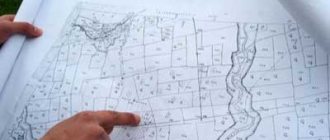Land survey disputes are a very common phenomenon in Russia. Many Russian residents are land owners. Almost every 3-4 Russians have a dacha or a small vegetable garden.
Unfortunately, not all owners timely and correctly register their property rights and carry out land surveying.
As a result of such negligent attitude in legal practice, such a term as “landmark disputes” arose and became entrenched.
This term is usually used to denote a conflict situation (dispute) that has arisen over the impossibility of establishing an exact (satisfactory) boundary between neighboring plots (boundaries).
As a rule, the plot was inherited from relatives. And those, in turn, received the distribution from the collective farm or enterprise. In Soviet times, no special papers were required to own it. But in order to prove ownership these days, land surveying is necessary, on the basis of which a land dispute arises.
Why are site boundaries needed?
By defining the boundaries of his own plot, its owner receives a number of significant advantages:
- Fixes and legitimizes the real size. Knowledge of specific numerical designations is necessary when selling. In exchange for a certain amount, the buyer acquires a real plot of land, which eliminates possible land survey disputes with neighbors who use part of it for their own needs, and, accordingly, any land survey disputes in this area.
- Avoids problems during division. Knowing the total number of acres, it is easier to divide them between the heirs and allocate shares. Land surveying eliminates the manipulation of unscrupulous relatives; boundary disputes, if there is a boundary, are resolved quickly. As a rule, such a boundary dispute is resolved in arbitration.
- May not worry about unlawful actions of neighbors. Many previously abandoned sites are being used by neighboring property owners. These actions are not legal, but it is difficult to prove this without documents indicating the exact size of the allotment (interference). The presence of a boundary will solve this problem and eliminate the possibility of starting a long-term boundary dispute and a dispute in general.
Establishing boundaries (boundaries) is also necessary if there is a need to appropriate no-one's possessions. In most cases, these do not exist, but land surveying allows you to identify the exact owner and, together with him, carry out further actions to decide the future fate (rent, purchase and sale).
Illegal appropriation is a direct path to court regarding the emergence of a boundary dispute.
Example: Citizen Imin B.V. used a neighboring plot of land. He built a barn and planted a vegetable garden. The arrival of the owners of the site was a surprise, which became the reason for the outbreak of a boundary dispute. The illegal user actually did not know that it was in someone else's possession. The new owner also had no idea that there were no land surveys between the plots, so he would not be able to use the property for its intended purpose immediately without a land survey procedure. The boundary dispute was resolved in court, but the very fact that such a dispute arose confirms the need for timely surveying with the involvement of boundary engineers.
How to notify a neighbor (and whether it is necessary) about land surveying
The main thing to remember is to notify your neighbors. The first method to try is personal collection of consents. In this case, you should print out notifications and go around all the neighbors yourself. This method is good when adjacent plots are not in disrepair and the owners are known.
If there is no real opportunity to see the owners of the land, then, if you have information about their residential addresses, you can send notifications by mail. It is better to send by registered mail. The postal service will be responsible for delivering this document.
It is also worth remembering that you will have to notify at least three times. There must be a 3 week interval between shipments.
In the absence of information about the owners, it will be necessary to publish it in the media. You need to perform these steps 3 times. All newspaper issues should be retained. They may be needed if the owner of neighboring lands shows up and, being dissatisfied with the results of the land survey, tries to challenge them in court.
Our recommendations: “Everyone has the right to privacy, or is it possible to install a blank fence between neighboring areas.”
Boundary plan and project
Issues of determining the area of an allotment and its ownership are under the control of regional executive authorities. Responsible for issues of land management and land resources.
Employees of these authorities issue a technical passport to the owner, determine the boundary plan and draw up an act of control over their safety. They do not resolve land survey disputes, but they make every effort to ensure that they do not arise.
A boundary plan is a document that indicates the exact dimensions and boundaries of the property, lists access roads, as well as engineering buildings of public importance.
The boundary plan is the basis for compiling the cadastral register and is presented in the form of text and graphic drawings. It is being developed by an organization that the property owner has entrusted with geodetic surveying.
Data about the land survey site (size, boundaries, access routes, presence of water supply, gas pipe, etc.) are included in the land survey plan only after the land survey project has been approved. Work in the field of land surveying is carried out by a cadastral engineer, guided by the current norms of the legislation of the Russian Federation.
The main law regulating land surveying issues is currently Federal Law No. 78-FZ dated June 18, 2001 (as amended on July 13, 2015) “On Land Management” (as amended and supplemented, came into force on 01/01/2016).
After drawing up the design part of the boundary plan, the engineer submits it for review and further approval by the owner. If there are several of them, then the boundary draft, in order to avoid a boundary dispute, is sent for approval to everyone who has a property interest.
As soon as the owner has signed the boundary project, he has the right to apply for a certificate of ownership of the property with all the changes made. New information about land surveying is entered into the cadastral register, where it is stored until subsequent changes are made.
The land surveying procedure is carried out only if documents are available.
To avoid quarrels with neighbors, they are informed about the upcoming measurement of the land area no later than 7-8 days before the survey engineer appears on the site. Having received such a notification, the neighbor is deprived of the opportunity to start a land survey dispute based on his lack of information about the upcoming land survey.
Other Possible Problems
- Incorrect definition of plot boundaries. When carrying out land surveying, the rights of neighbors can be infringed;
- occurrence of technical errors when preparing documents. If such problems exist, registration will be denied;
- lack of proper training and experience of the specialist carrying out the work. This happens if the owner decides to save money on a surveying company;
- lack of agreement between relatives who are dividing a single plot. Such land surveying is possible only by court decision.
If you have sufficient communication skills, you can try to solve any problem that arises with defining the boundaries of adjacent areas. If, however, the dispute cannot be resolved peacefully, then the court will be the last resort. A decision that has entered into legal force is binding. This will be the best guarantee of protecting your rights.
Did you like the article? Like ♥, subscribe to our channel and you will be one of the first to know about new publications!
And if you have something to share, leave your comments! Your feedback is very important to us!
Documentation
To install a boundary post and avoid a dispute over the boundary, you need:
- documents on ownership and right to use land;
- passport of the person who expressed a desire to carry out land surveying;
- application (submitted to a company licensed to conduct geodetic measurements);
- cadastral passport (if you don’t have it on hand, an extract from this document can be a replacement);
- boundary plan;
- a certificate confirming the presence or absence of public communications in the intervening territory (water supply, gas pipe, telephone cable may cause a dispute).
The specific list of papers depends on the region, the nature of the boundary dispute, and the economic purpose of the plot to be demarcated.
Note! In order not to return to the controversial issue of boundaries in the future, special boundary signs (poles) are installed between nearby areas. It is illegal to independently move boundary markers in any direction. If this happens, then the land surveying procedure will have to be repeated (moving the boundary post is a reason for a dispute in court on the issue of land surveying).
Limitation of actions
General rules apply to disputes. The statute of limitations is 3 years. It begins to be calculated from the moment the applicant becomes aware of violations against his rights.
It is often difficult to establish the exact date of reference when the violation was discovered. In this case, the court may reinstate the term. But to do this, you must submit a separate application or apply for an increase in time at the first meeting.
Thus, you can resolve a dispute about the boundaries of a land plot yourself or with the involvement of a court. In the first case, it will take a little time. But if one of the parties does not seek to resolve the conflict, you can resort to litigation.
Land survey disputes - procedure
To survey the property, the owner is obliged:
- contact a geodetic organization and conclude an agreement with it on carrying out the necessary land surveying work;
- notify the owners of all plots with which his lands do not have a boundary (their presence is a prerequisite, since they are required to express their oral or written consent to the boundary).
Arriving cadastral engineer:
- measures the area of the site;
- records the obtained values in the survey report (the document is signed by the surveyor, the owner of the site, neighbors, representatives of local authorities).
After the specialists leave, the owner contacts the organization’s office to issue him a land survey plan. It takes up to 30 days to develop it. The customer is notified in advance of the deadline for drawing up the document at the stage of the boundary procedure.
Having collected this package of documents, the owner submits it to the State Register for registration.
If the boundaries of the property are changed after the documents have been submitted and all changes have been made, the survey will be carried out again. If the owner does not do this, he will not be able to exercise his right to use the site. It will be difficult to sell, lease legally, as well as perform any manipulations requiring official registration with such land, since its actual status will not be determined (there is no boundary).
Carrying out work without the consent of neighbors
There are situations when a notice () was sent to the interested person and he received it, but did not react in any way. That is, he did not agree with him and did not formulate a reasoned refusal to answer.
Then the boundary can be considered consistent. In this case, it is necessary to record the fact that there was no refusal and attach documents that would confirm that the notice was sent to the neighbor.
Also, a written refusal, if any, should be attached to the approval act. This must be done to ensure that the approval procedure is followed, because if it is not followed, the land will not be registered in the Unified State Register of Real Estate.
After 30 days, you can call people for a second agreement.
Types of boundary disputes
A boundary dispute is always a dispute between neighbors, the subject of which is land, but the nature can vary significantly.
There are types of boundary disputes that arise:
- if neighbors have no information about the land survey that took place;
- when carrying out a land surveying procedure in violation of the law;
- between neighbors of nearby plots, if one of them refuses to restore the other’s violated rights;
- between neighbors, one of whom believes that the other has committed illegal actions against him (he has appropriated part of the land that does not belong to him);
- in the absence of any procedures to determine the exact boundaries of the site (land surveying has never been carried out).
Most often, neighbors try to resolve such boundary disputes on their own. By establishing an approximate boundary between plots and constructing a fence.
Unfortunately, the lack of legal justification for what happened in the future can lead to aggravation of the conflict situation between their heirs or new owners.
Example: Citizen Avdeeva I.I. received land ownership for farming. It was allocated to her in 1964. Her neighbor, citizen Ilyushina A.I., received similar land. Since both were civilly related, they decided not to establish a clear boundary between the property (the boundary) and did not even have a fence.
In 2009, Avdeeva I. I dies, her land becomes the property of her son, citizen Avdeev I. N. In turn, the neighboring property has already been owned by the granddaughter of the late Ilyushina A. I. for some time.
Having decided to sell the inheritance he received, Avdeev I. N. was faced with a problem such as the lack of a clear boundary between his plot and the plot of his neighbors (there was no demarcation). No documents have survived regarding the exact size of the land. Therefore, for a long time the neighbors used most of the plot that belonged to I. N. Avdeev for their own needs (garden). In order to sell the inheritance, the specified citizen entered into a boundary dispute with his neighbors regarding the return to him of the unauthorized portion of the inheritance. To resolve the boundary dispute, he went to court.
Why do disagreements arise?
The main reasons for conflicts are simple:
- the land is registered according to the law, but the boundaries of the site have not been clarified;
- one of the neighbors deliberately occupied part of the land of another in the hope that he would be too lazy to defend his rights;
- the boundaries were violated accidentally during the operation of the plots: when the fence was changed or some major earthworks were carried out on the plot;
- there was an agreement between the neighbors to change the boundaries of the plot for a certain period (for example, they were friendly, and one gave part of his plot to the second). Over time, the agreement became irrelevant (for example, the plots were inherited), and it was necessary to return the boundaries specified in the Unified State Register.
Examples of boundary violations:
- the fence demarcating the territories has been displaced or lost;
- a neighbor built a new fence with partial seizure of someone else's territory;
- the owner built a capital structure with the seizure of neighboring land.
The requirement depends on the type of violation: return the borders or demolish the illegal building.
How to resolve a conflict
A lawsuit is one of the options for resolving a boundary dispute, but it is far from the best. Therefore, we will consider the possible actions of boundary disputants in more detail.
Peaceful solution
If neighbors have claims against each other after the land surveying procedure, they can still resolve them peacefully.
To do this you should:
- Carry out points on the terrain. The parties to the conflict invite specialists from the land management organization. Which mark certain points on the site that has become the subject of a boundary dispute. The location of which is included in the state register. The marked coordinates will be the boundaries of the site. In most cases, their definition becomes sufficient to reduce tension between neighbors to a minimum.
- Carry out the surveying procedure again. You can invite other specialists or require the presence of all neighbors. Those who took part in such a procedure during the initial paperwork and remember the approximate location of the boundary.
The surveying procedure must be carried out by an organization (commercial company) that has the appropriate license.
Without a license, installing a boundary line is considered illegal. Even if the correct calculations were used and the person in charge had the appropriate education.
Going to court
In paragraph 1, art. 64 of the Land Code of the Russian Federation states that the resolution of any land disputes, including boundary disputes, takes place in court. In paragraph 2 of the article in question, it is noted that before the case is transferred to an ordinary court, an arbitration court can deal with it. This opportunity arises only if an arbitration agreement is concluded between the parties to the conflict.
If the parties to the conflict are determined and each of them represents himself in this boundary dispute as an injured party, then the case is heard in an ordinary court.
After submitting the following documents to the office:
- land management business. All documents that indicate boundaries, dimensions, length, and coordinates of boundary markers. Cadastral plan, information about notification of persons whose interests are affected by the land surveying procedure;
- papers evidencing ownership of land. Which each side has. Each participant in a boundary dispute provides his own evidence base;
- conclusion of a land management expert. Provided if the completed land surveying procedure did not satisfy one of the owners, and disputes regarding land surveying arise;
- eyewitness accounts. If there were witnesses present during the transfer of land to the first owner and the installation of boundary signs, then their testimony should definitely be included in the case regarding the resolution of the boundary dispute.
Note! The defendant in a boundary dispute case has the right to file a counterclaim. Therefore, one cannot count on the fact that in the eyes of the court he will look like the culprit of the boundary dispute, and the plaintiff the injured party.
In addition, the defendant can also challenge the court's decision. What may cause an increase in the time for consideration of a boundary dispute (up to 2 or more months).
To obtain more complete information about the current situation, representatives of the judicial authorities have the right to conduct a personal inspection of the disputed territory requiring land surveying.
The final decision is made by the judge. Therefore, a lot depends on his literacy and desire to understand the problem that has arisen, having studied all the evidence provided as fully as possible.
Trial: procedure
The plaintiff can participate in court in person or enter into an agreement with a lawyer. It is important to seek the help of a qualified specialist whose practice is land and property disputes. If you win the case, the defendant will bear all your costs for the trial and the involvement of specialists.
According to Art. 30 of the Code of Civil Procedure of the Russian Federation, the claim must be filed in the territorial court. That is, in this case it is submitted to the court, which is located at the location of the site. In this case, the following consideration procedure is established:
- The Magistrate's Court considers disputes related to determining the procedure for using property, which includes land plots.
- The district court considers issues related to the establishment of boundaries.
If a positive decision is made, it will take effect within 30 days. During this time, the defendant can file an appeal to a higher authority, up to the Supreme Court of the Russian Federation.
In accordance with Articles 14 and 61 of Federal Law No. 218, the court decision is transferred to Rosreestr. It may require the correction of an error or the registration of property. To speed up the process, you can take a certified copy from the court with the writ of execution and submit them to Rosreestr yourself.
Fixing a registry error
If registration errors are made, which periodically occur when entering data on land plots, experts recommend sending requests to the territorial department of Rosreestr to correct the technical inaccuracy.
Employees of such a government body can correct the error on their own, but in practice most often they have to go to court , based on whose decision the necessary changes are made.
Going to court
The court is the last resort to help when complaints to the local administration and conversations with neighbors no longer help. The decision made by the court is mandatory for execution throughout the entire territory of the Russian Federation. If the neighbors refuse to do this voluntarily, the bailiffs will oblige them to comply.
To get results, it is best to file a class action lawsuit for the misconduct of your neighbors. Such cases are considered more carefully and have a greater chance of a decision being made in favor of the plaintiff.
Keeping pets
The pet category includes not only cats and dogs, but also pigs, chickens, goats, etc. To prevent their presence from causing problems, animal owners must adhere to the following standards:
- Before getting pets, check that this does not conflict with local laws established by the village administration.
- Create conditions for their living in a designated area.
- Take care of your pets daily: clean their cages, feed them, and prevent them from leaving the area.
In addition, products obtained from animals, such as milk or meat, cannot be used for sale. Such actions are regarded as unregistered business activity.
Number of pets
Federal Law 498 does not indicate the maximum permissible number of pets. However, it contains provisions regulating sanitary and epidemiological safety. They boil down to the fact that pets are cared for, including regular feeding, changing water and cleaning.
Federal Law-52, which is a universal law on regulating silence, is also used when measuring noise from pets. The following regulations apply in this regard:
- at night the noise level cannot exceed 30 dB;
- during the day the noise level cannot exceed 50 dB.
The private sector in which people live is also subject to these rules, as well as noise laws. If a violation by animals is detected, the owner will have to refuse to keep them.
Placement of structures without violating the law
Placing buildings on land is often the reason for increasing land taxes, as well as a frequent cause of disputes between neighbors. This is due to the following reasons:
- the process of determining who is responsible for the determination;
- demands to move the building away from someone else’s border;
- requirements not to put up buildings, since the shadow prevents sunlight from entering.
To regulate all controversial issues, the competent authorities turn to the rules for the construction of construction projects.
General rules for the location of buildings
Legislative norms have several rules that are most often used in construction disputes:
- Objects cannot block access to light and air on someone else's property.
- The distance from the fence to the wall of the house must be at least 3 m.
- From the toilet to the fence - at least 1 m. Also, the length from the toilet and the entrance door to the house on the neighboring site must be at least 8 m.
- Facilities cannot interfere with neighboring residents' use of their land.
We recommend reading:
Law on silence in apartment buildings
Negotiation
The resolution of any conflict must begin with negotiations. Sometimes violations occur not because of malicious intent, but because of ignorance of the laws. In order not to lose good neighborly relations and maintain your reputation, you should talk to your neighbors and explain the problem. This will also help save time and money that would have to be spent to resolve the issue in court. If there is an opportunity to peacefully agree on everything, you should not miss it.
During the conversation, it is worthwhile to paint a picture of what happened, refer to the legislation and the inadmissibility of certain actions. It is worth notifying neighbors that if the problem is not resolved, a complaint will be sent to local authorities.
Access to sunlight
The land is primarily used for gardening. In order for planted plants to produce a harvest, they need sunlight, and therefore the buildings of neighbors cannot interfere with its spread. Access to sunlight is required for at least three hours a day. If a neighboring property violates this requirement by its presence, a decision will be made to demolish it or dismantle the upper floors.
In the private sector, where small plots of land are located, their intended use is not provided for. Owners can build any objects here that comply with urban planning standards. This makes dachas cheaper compared to lands intended for residential areas.
Features of land management expertise
A land management examination is appointed when eliminating errors or inaccuracies in the documents compiled on land plots and, in particular, when establishing the actual boundaries of the allotment .
During the examination, preparatory work is carried out, measurements of the allotment are carried out, boundaries are drawn out in kind, a site plan is developed, and then a report on the work performed is drawn up.
The drawn up examination report includes a conclusion about what actions were carried out, as well as information about the possibility of carrying out certain actions with the allotment.
There should be snow catchers on the roof: a court for the safety of neighbors in the area
In 2021, in Bashkortostan, citizen N filed a lawsuit against his neighbor demanding to change the configuration of the roof on his garage, install snow retention devices and compensate for moral damages.
The roof of the neighbor's building was located in such a way that snow flowed from it onto the plaintiff's property and created discomfort (difficult to walk and impossible to park the car), and in case of ice, a danger to the health of his family members.
The court satisfied the plaintiff's demands (with the exception of compensation for moral damage) and ordered the defendant to install snow retention devices.











